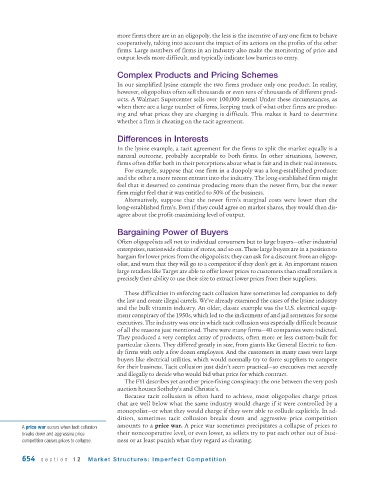Page 696 - Krugmans Economics for AP Text Book_Neat
P. 696
more firms there are in an oligopoly, the less is the incentive of any one firm to behave
cooperatively, taking into account the impact of its actions on the profits of the other
firms. Large numbers of firms in an industry also make the monitoring of price and
output levels more difficult, and typically indicate low barriers to entry.
Complex Products and Pricing Schemes
In our simplified lysine example the two firms produce only one product. In reality,
however, oligopolists often sell thousands or even tens of thousands of different prod-
ucts. A Walmart Supercenter sells over 100,000 items! Under these circumstances, as
when there are a large number of firms, keeping track of what other firms are produc-
ing and what prices they are charging is difficult. This makes it hard to determine
whether a firm is cheating on the tacit agreement.
Differences in Interests
In the lysine example, a tacit agreement for the firms to split the market equally is a
natural outcome, probably acceptable to both firms. In other situations, however,
firms often differ both in their perceptions about what is fair and in their real interests.
For example, suppose that one firm in a duopoly was a long-established producer
and the other a more recent entrant into the industry. The long-established firm might
feel that it deserved to continue producing more than the newer firm, but the newer
firm might feel that it was entitled to 50% of the business.
Alternatively, suppose that the newer firm’s marginal costs were lower than the
long-established firm’s. Even if they could agree on market shares, they would then dis-
agree about the profit-maximizing level of output.
Bargaining Power of Buyers
Often oligopolists sell not to individual consumers but to large buyers—other industrial
enterprises, nationwide chains of stores, and so on. These large buyers are in a position to
bargain for lower prices from the oligopolists: they can ask for a discount from an oligop-
olist, and warn that they will go to a competitor if they don’t get it. An important reason
large retailers like Target are able to offer lower prices to customers than small retailers is
precisely their ability to use their size to extract lower prices from their suppliers.
These difficulties in enforcing tacit collusion have sometimes led companies to defy
the law and create illegal cartels. We’ve already examined the cases of the lysine industry
and the bulk vitamin industry. An older, classic example was the U.S. electrical equip-
ment conspiracy of the 1950s, which led to the indictment of and jail sentences for some
executives. The industry was one in which tacit collusion was especially difficult because
of all the reasons just mentioned. There were many firms—40 companies were indicted.
They produced a very complex array of products, often more or less custom-built for
particular clients. They differed greatly in size, from giants like General Electric to fam-
ily firms with only a few dozen employees. And the customers in many cases were large
buyers like electrical utilities, which would normally try to force suppliers to compete
for their business. Tacit collusion just didn’t seem practical—so executives met secretly
and illegally to decide who would bid what price for which contract.
The FYI describes yet another price-fixing conspiracy: the one between the very posh
auction houses Sotheby’s and Christie’s.
Because tacit collusion is often hard to achieve, most oligopolies charge prices
that are well below what the same industry would charge if it were controlled by a
monopolist—or what they would charge if they were able to collude explicitly. In ad-
dition, sometimes tacit collusion breaks down and aggressive price competition
A price war occurs when tacit collusion amounts to a price war. A price war sometimes precipitates a collapse of prices to
breaks down and aggressive price their noncooperative level, or even lower, as sellers try to put each other out of busi-
competition causes prices to collapse. ness or at least punish what they regard as cheating.
654 section 12 Market Structures: Imperfect Competition

